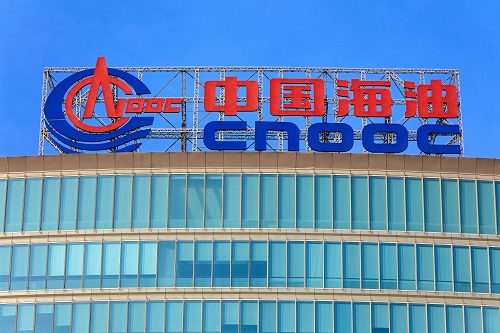CNOOC Stockpiles Russian Oil at New Reserve Base in China
(Reuters) — State-run China National Offshore Oil Co., one of the country's top importers of Russian oil, has in recent months been pumping shipments of ESPO blend from Russia's Far East into a newly launched reserve base, according to traders and tanker trackers.
This is the first-time stockpiling of Russian ESPO blend crude at CNOOC's new reserve base has been reported. CNOOC did not have an immediate comment.
The stock build, estimated at more than 10 million barrels by tanker tracker Vortexa Analytics, helped lift China's seaborne imports of the flagship Russian export grade to a record high in March, supporting prices of the ESPO blend despite tepid demand from independent Chinese refiners.
Though less than China's crude consumption in a day, the stock build cements Russia's position as China's top oil supplier and comes as sales to India, Moscow's No.2 oil client since the war in Ukraine, slowed due to western sanctions-driven difficulties over payments and shipping.
CNOOC began pumping the Russian crude last November into the 31.5 million-barrel storage base it has built in east China's Dongying port, according to trading sources and Vortexa.
"ESPO discharges into Dongying began surging ... after the port put into use three new berths able to dock Aframax vessels," said Emma Li, Vortexa's senior China oil analyst. Each ESPO cargo is about 100,000 metric tons or 740,000 barrels and the oil is typically carried in Aframax-sized tankers.
Vortexa did not specify whether the 10 million barrels were part of CNOOC's commercial stock build or for China's strategic petroleum reserve, but two senior traders who closely track ESPO flows said Beijing has been boosting its emergency stockpile.
"This is part of what the government has repeatedly called for, which is to hold the bowl of energy security firmly in our own hands," one of the traders said on condition of anonymity given the sensitivity of the matter.
China, the world's largest crude oil buyer, tightly guards information on its emergency government stockpile and private estimates of China's strategic reserve vary widely.
Vortexa put China's strategic reserve levels at 280 million barrels, while consultancy Energy Aspects pegged them at 400 million barrels. By comparison, the U.S. Strategic Petroleum Reserve stands at roughly 364 million barrels.
Russian oil arrivals into China, including via pipelines under long-term contracts, rose one quarter last year to a record 2.14 million barrels per day (bpd), making Moscow its top supplier for a second straight year, ahead of former top provider Saudi Arabia's 1.72 million bpd.
China's National Food and Strategic Reserves Administration did not respond to a Reuters request for comment.
'Safeguard National Energy Security'
Overall, about 29 million barrels of ESPO blend were discharged between November and March into Dongying port, of which 19 million barrels were sold to independent refiners known as teapots while the rest was stockpiled, according to Vortexa.
At 10 million barrels, the stockpile would occupy one-third of the capacity at the CNOOC-built Dongying storage site, which began operation in February 2023. China processes roughly 15 million barrels of crude oil a day.
The 6.4-billion-yuan ($885 million) tank farm is a tie-up to "jointly safeguard national energy security", the Shandong provincial government said last year when the storage site was launched.
The site, situated near CNOOC's offshore oilfields, also helps CNOOC market its own production to Dongying, home to 32 independent refineries.
Before last November, the Dongying site was used mostly to store offshore crude and fuel oil, Vortexa's Li said.
China's overall seaborne ESPO imports hit a record 28.7 million barrels in March, data from analytics firm Kpler showed.
Of that, CNOOC purchased a record 8.5 million barrels in March, of which 7.4 million barrels were imported at Dongying, Kpler data showed. This compares with 5.2 million barrels imported at Dongying each in January and February, 3.7 million barrels in December, and 1.4 million barrels in November when ESPO imports to the site began.
"Lower demand from India prompted more Russian oil sales to China as really there are not many countries that can take Russian oil now," an ESPO dealer said.
($1 = 7.2330 Chinese yuan)
Related News
Related News

- Kinder Morgan Proposes 290-Mile Gas Pipeline Expansion Spanning Three States
- Valero Plans to Shut California Refinery, Takes $1.1 Billion Hit
- Three Killed, Two Injured in Accident at LNG Construction Site in Texas
- Tallgrass to Build New Permian-to-Rockies Pipeline, Targets 2028 Startup with 2.4 Bcf Capacity
- TC Energy Approves $900 Million Northwoods Pipeline Expansion for U.S. Midwest
- U.S. Pipeline Expansion to Add 99 Bcf/d, Mostly for LNG Export, Report Finds
- US Poised to Become Net Exporter of Crude Oil in 2023
- EIG’s MidOcean Energy Acquires 20% Stake in Peru LNG, Including 254-Mile Pipeline
- Construction Begins on Ghana's $12 Billion Petroleum Hub, But Not Without Doubts
- Valero Plans to Shut California Refinery, Takes $1.1 Billion Hit





Comments